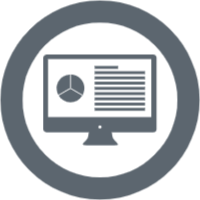Workforce Planning and Analytics Organizational
Description
Making the business case for frontline workforce investments requires both quantitative data and qualitative storytelling. Organizations with the capacity to collect and analyze data can better forecast talent development needs and make more informed decisions when developing a workforce plan. Several business units may need to work together to gather and analyze the desired data. Workforce plans are more readily adopted when the data supports an organizational priority and workforce initiatives are aligned to business needs.
Process
Workforce plans and analytics should align with organizational goals for maximum value. Each person tasked with gathering and reporting data should know how the data is used and how it contributes to organizational goals. Some of these goals might be:
- Reducing turnover
- Improving recruitment efficiency or effectiveness
- Lowering costs
- Ensuring talent is aligned to new initiatives or growth
The following metrics provide valuable insight to inform strategic decisions.
Internal workforce
- How long employees stay in a position or with an organization, i.e., retention
- Rate of lateral moves and promotions
- Rates of retirement, voluntary departure, layoffs, and terminations
Recruitment
- Number of days to fill a position
- Number of applicants screened vs. hired
- Number of qualified applicants per posting
- Analysis of recruitment sources
Cost and productivity
- Time to reach proficiency in a new job
- Cost of hiring and training a new employee
- Cost of using a temporary employment agency
Use this data to identify workforce needs and challenges, and then build a workforce plan to address them. Consider how strategies impact both external and internal talent pipelines. Ensure your strategy effectively tackles the issues revealed by the data. For example, if data shows that it is more cost effective to upskill current employees than to use an agency, assess what employees need to advance and develop programs that support them to learn and move into higher positions.
CareerSTAT Members Implementing This Practice
Resources
Developing an Effective Healthcare Model, American Hospital Association.
A white paper with useful data and insights and an assessment tool to help organizations develop effective workforce planning models.
Workforce Development Planning Template, National Fund for Workforce Solutions
Cost of Turnover Tool, The Aspen Institute Workforce for Strategic Initiative, 2019.
A simple, “back of the envelope” calculator to help you estimate how much it costs your business to replace staff.
The Imperative for Strategic Workforce Planning and Development: Challenges and Opportunities, American Hospital Association, 2016.
A report by hospital leaders and healthcare experts that identifies key workforce challenges and includes a workforce planning assessment tool.
Applying Analytics Can Enhance Workforce Planning, Stephen Miller, June 19, 2016.
Article outlining rationale and metrics to apply for modeling workforce planning. Summary of SHRM conference presentation.
Human Capital Institute 2018 Workforce Planning & People Analytics Conference
Website contains conference presentations with multiple perspectives, models and experiences with workforce planning and analytics.
Related Best Practices
Provide Structured Onboarding of New Hires
PROGRAMMATIC | The transition to a new job is often challenging, especially for workers moving from unemployment or a non-clinical environment.
Read MoreBasic Skill Development
PROGRAMMATIC | Entry-level employees don’t always have the reading, math, technology, or English language skills to excel in their current position or advance their career.
Read MoreLeverage Partner Expertise and Resources
ORGANIZATIONAL | When selecting partners, develop an assessment process to determine which organizations have the capacity, expertise, and ability to deliver quality service.
Read MoreSupportive HR Policies
ORGANIZATIONAL | To truly develop the frontline workforce, you need more than programs or initiatives designed for them.
Read MoreDedicated Workforce Staff or Units
ORGANIZATIONAL | Having a dedicated position or even entire units devoted to frontline workforce development is critical to prioritizing and scaling an effective workforce strategy.
Read MoreInclusive, Local Hiring
PROGRAMMATIC | Healthcare employers strive to have a workforce that reflects the communities they serve.
Read More


